

Pinterest's Copyright Strategy Puts the Burden on Users. Pinterest, the social network that encourages image hoarding, hasn't done a very good job preparing for the inevitable copyright scandal the site will face.
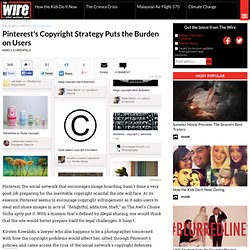
At its essence, Pinterest seems to encourage copyright infringement as it asks users to steal and share images in acts of "delightful, addictive, theft," as The Awl's Choire Sicha aptly put it. With a mission that's defined by illegal sharing, one would think that the site would better prepare itself for legal challenges. It hasn't. Kirsten Kowalski, a lawyer who also happens to be a photographer concerned with how the copyright problems would affect her, sifted through Pinterest's policies, and came across the crux of the social network's copyright defenses. From her blog: And this is where I got really nervous.
Pinterest puts the burden on the user, rather than itself, asking Pinners (in giant, scary CAPS) to agree that risk related to the "application of services" -- i.e. stealing -- remains with YOU. Pinterest for Educators? After hearing about all the hoopla surrounding Pinterest, I decided to check it out and see if it had any value to me as an educator.
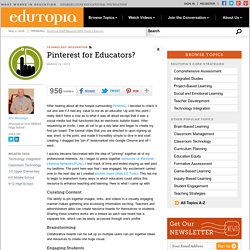
Up until this point I really didn't have a clue as to what it was all about except that it was a social media tool that functioned like an electronic bulletin board. After requesting an invite, I was all set to go a day later and began to create my first pin board. The tutorial video that you are directed to upon signing up was short, to the point, and made it incredibly simple to dive in and start creating. I dragged the "pin it" bookmarklet into Google Chrome and off I went. I quickly became fascinated with the idea of "pinning" together all of my professional interests. Curating Content The ability to pin together images, links, and videos in a visually engaging manner makes gathering and accessing information exciting. Brainstorming. Pinterest piqued in UK for 'creative, pretty and completist' social network. After rapid growth in the US, the hottest new social network on the internet is starting to take off in the UK – with an unusually high proportion of women users.
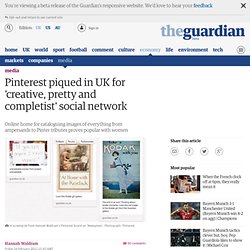
If you've ever cut out something from a magazine, collected stickers in the playground, or made a photowall of your favourite postcards, chances are you'll understand the attraction of Pinterest.. Dubbed the "Tumblr for mums", Pinterest allows people to create online displays of their likes and interests – from home decor to nail art – by "pinning" images and videos on to virtual boards. It has grown rapidly in the last six months, driven largely by tech blogs and word of mouth. Reliable figures on the site's 12m monthly unique users are hard to come by, as the 10-strong team in Palo Alto, California, went quiet after Pinterest's popularity surged, but its reported "pinners" in the US are somewhere between 57% and 97% female. Early figures suggest the gender balance of the UK's 200,000 users is more even. Six things I learned from six days on Pinterest. Just what the world needs--another social network!
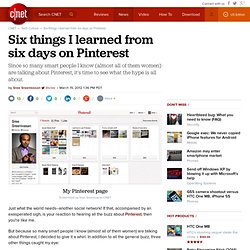
If that, accompanied by an exasperated sigh, is your reaction to hearing all the buzz about Pinterest, then you're like me. But because so many smart people I know (almost all of them women) are talking about Pinterest, I decided to give it a whirl. In addition to all the general buzz, three other things caught my eye: You can see my baby steps on Pinterest here. And you can watch me discuss Pinterest 101 on WCBS-TV in NYC here, with anchors Rob Morrison (@RobMorrison1) and Mary Calvi (@MaryCalvi).
3 Things to Know About Your New Pinterest Profile. Pinterest began rolling out new profile pages today (March 16) that put more emphasis on the people behind the photos.
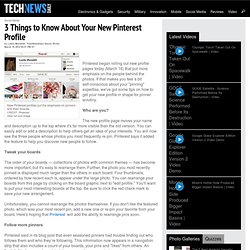
If that makes you feel a bit self-conscious about your "pinning" expertise, we've got some tips on how to get your new profile in shape for pinner scrutiny. Who are you? The new profile page moves your name and description up to the top where it's far more visible than the old version. You can easily edit or add a description to help others get an idea of your interests. You will now see the three people whose photos you most frequently re-pin. Tweak your boards The order of your boards — collections of photos with common themes — has become more important, but it's easy to rearrange them.
Unfortunately, you cannot rearrange the photos themselves. Follow more pinners. Everything Pinterest and Tumblr Users Need To Know About Copyright Law. Media_http6mshcdncomw_utmeA.png.scaled500.png (Image PNG, 500x1574 pixels) The Ultimate Guide To Pinterest. Know Your Internet: What Is Pinterest and Why Should I Care? - Alexis Madrigal - Technology. On the cold, crowded beach that is the Internet, another monster wave has been spotted on the horizon.
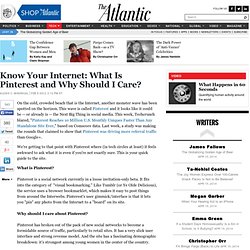
This wave is called Pinterest and it looks like it could be -- or already is -- the Next Big Thing in social media. This week, Techcrunch blared, "Pinterest Reaches 10 Million U.S. Monthly Uniques Faster Than Any Standalone Site Ever," based on Comscore data. How Educators Use Pinterest for Curation. Digital Tools Jody Strauch By A.

Adam Glenn The phenomenal growth of Pinterest has sparked interest among millions of users. It’s also spread to journalism educators, who are increasingly experimenting with it in the classroom. The social network launched two years ago, but in recent months has drawn red-hot excitement for its unique visual, topic-based curation approach.
Now journalism school faculty are increasingly in on the act. One early adopter was University of Southern California’s Andrew Lih, who last October, long before he and many others knew the site would become a blockbuster, introduced it to online students in an entrepreneurial class to gather what he called a “mood board” for a project on public art. Aggregating images to share with students is an increasingly common classroom use for the tool.